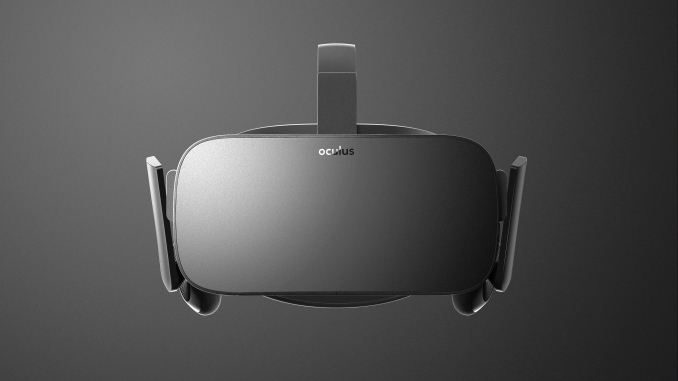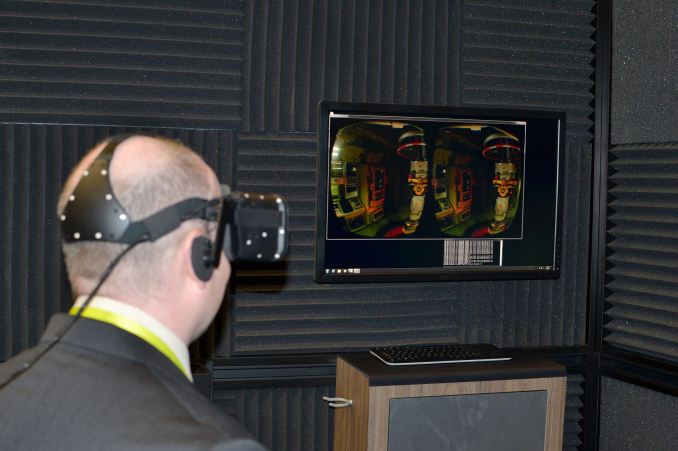Oculus Targets Q1 2016 for Consumer Oculus Rift
by Ian Cutress on May 6, 2015 2:57 PM EST- Posted in
- VR
- Oculus Rift

So far I’m the only one on the AnandTech staff that has had a go with three of the major VR players: Oculus’ Rift (Crescent Bay), HTC Vive and Samsung Gear VR. Throughout every demo, the question has always been ‘when, when, when?’. It’s been almost three years since the initial Oculus Kickstarter, and we’ve seen the headset grow in terms of investigating the issues surrounding VR as well as the feel and the content. This morning Oculus announced that ‘Q1 2016’ is the date where consumers will be able to buy a retail version of the headset, or by the end of March.
Up until this point, users and developers could buy a development kit with non-final hardware to both test and experiment how to write code and interfaces that can use virtual reality. Oculus will start taking pre-orders for the full retail version later this year. One of the big issues, for me personally, is that VR needs to launch with ground-breaking AAA titles – at least one, if not two. There’s no indication as to what games might be launching in that time, but hopefully they have been working closely with particular game developers to ensure good performance on day one.
At CES this year, when I tested Oculus, hardware specifications were hard to come by. We knew the display was at 90 Hz, requiring a black frame every other frame in order to prevent ghosting. The key take-home message from Brendan Iribe, CEO of Oculus, at the time was that they wanted more. Higher resolution per eye and faster refresh rates were the two key factors, along with what system was powering the content as both of those requirements puts a strain on current graphics solutions. Oculus is set to release details between now and launch, with next week featuring more of the technical specifications.
Brett testing Rift at CES
Pricing is yet unannounced, but other publications have put it in the ‘up to $400’ range, which is similar to the development kits ($350). If I remember correctly, Oculus stated to us in January is that they intent to offer the best VR experience when they launch, and potentially offer partners the chance to create kits themselves but Oculus will always be at the forefront of the technology and software curve in that regard.
Oculus is targeting the Rift at ‘gaming, film, entertainment, communication, and much more’. All angles point to PC content first, although I’m sure that something done with a console can’t be far behind.
PS: In case you missed them, we’ve posted pieces dealing with our hands-on of the Crescent Bay version of the Rift as well as the Vive in recent months.
Source: Oculus












14 Comments
View All Comments
webdoctors - Wednesday, May 6, 2015 - link
Ian,How does this compare to 3D glasses? Those always give me a headache and strain my eyes. Do these feel more natural?
kyuu - Wednesday, May 6, 2015 - link
These are nothing like 3D glasses. 3D glasses either use high speed shutters (the most headache inducing kind) or polarization to present different images to each eye. With headsets like the Oculus, each eye is simply being presented with different images. I don't think eye strain has been reported as an issue by many people, if any.Nausea, on the other hand, is an issue for some. My experience with even the most recent dev kit was a nausea-fest. And no, I don't get motion sickness.
SleepyFE - Thursday, May 7, 2015 - link
The thing with 3D is that you get headaches because not everyone's eyes are spaced apart at the same distance, while the images the TV shows are one distance only. If that is too different from your eyes your brain has a problem with that and it makes you know it with a headache.You might have the same problem with VR, but i haven't heard of it. Nausea is induced, because your visual and physical senses don't match (it looks like you're on a roller coaster, but you fell like you are sitting still). That is a more difficult fix and you may need to get a "rocking chair".
jim32 - Thursday, May 7, 2015 - link
I didn't feel nauseous when I tried out Oculus even though I get sick on a boat.mkozakewich - Wednesday, May 6, 2015 - link
There are different lenses, so at least you can set a comfortable viewing distance.If you get a headache when things aren't natural, this probably will be the same.
Mushkins - Thursday, May 7, 2015 - link
Honestly, I expect this thing to completely flop in the consumer space. Don't get me wrong, it's an awesome piece of technology, but it's just too niche and like consumer 3D there are common health issues (eye strain, nausea, etc). A 3D TV that makes you nauseous is still an awesome TV with the 3D turned off, but you have that problem here and you have a $400 paperweight. And like any peripheral device, application support directly correlates to the size of the install base. No apps = no buyers, and in turn no buyers = no apps. This thing is a really expensive luxury toy, and not much else.jjj - Friday, May 8, 2015 - link
You are too pessimistic about the technology in general but this product might flop.First the price - you can take a 5.5 inch 1080p average quality screen that costs 20$ and maybe 15$ by next year , add a few cheap chips , e lenses and a lot of plastic and make it for less than 50$ to sell it at 99-149$.
Oculus will likely go for higher res, maybe flexible screen, maybe 2 screens so the cost will be higher. They might add the external cam but no need for a high res cam so that will be cheap. All in all no reason for the BOM to be above 100$ ( could be plenty lower) unless they got some crazy controller. So a retail price of 400$ would be outrageous, 200-250$ is far more likely.
200-250$ is a bit high but not terrible .
On the app side, all the mainstream games are the main attraction and then movies and TV made for the normal screen.So they already have more than enough of a market and plenty of time to build on that.
What might kill this first gen product is the external hardware ( it does for me) and the race for higher res and FPS.
Well, kill is relative, if they don't reach 10 mil units per quarter after a few quarters, they failed in my eyes but some might see it as a great success if they ship 1-2 million units per quarter.
The high screen res and high FPS problem is something everybody ignores. Everybody wants it but without thinking about the GPU needed to power it. Sure next year GPUs on 14/16nm will offer a big gain in perf but i really hope Oculus won't go for a 4k screen because requiring a 500$ GPU to use it would be a lot.Even 1440p at 90FPS wouldn't be that cheap on the GPU side.
So Oculus could be hurt because they aimed too high instead of good enough a good price.
Yojimbo - Friday, May 8, 2015 - link
"you can take a 5.5 inch 1080p average quality screen that costs 20$ and maybe 15$ by next year , add a few cheap chips , e lenses and a lot of plastic and make it for less than 50$ to sell it at 99-149$."If it were that easy, I don't think these various companies would be taking years to develop the technology.
jjj - Friday, May 8, 2015 - link
It actually is that easy on the hardware side.ifixit has teardowns for both dev kits, the first one was a 7 inch 1280x800 tablet screen and 4 or so small chips. The second one was using a 5.7 inch 1440p screen (normally used in the Note) and got slightly more complex on the addition of the external cam.
The hard part is head tracking fast enough so on the software side.
The hardware itself is just a screen with lenses in front of it shoved in ski goggles.
As for screen prices ,they are that low for an average screen, more for OLED, higher res and so on. Unlike smartphones, Oculus doesn't need the touch layer so even a plastic OLED 1440p like in the Edge might be just 50$ by next year.
That's what's great about Oculss, it was way simple and cheap.
Akrovah - Friday, May 8, 2015 - link
10 mil per quarter or it's a failure? Really? Not even game consoles have that kind of volume. Even the Playstation 2, one of the best sellign game consoles in hsitory, only averaged 14 mil in a full YEAR and you are going to call Occulus, a much more niche product, a failure if they don't meet that every five months?